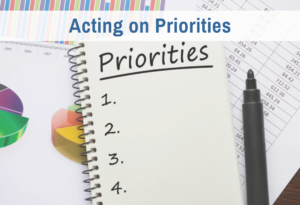Courses and articles on creativity drive me crazy. None of them get at what I see as the real issue. They all focus on brainstorming quantities of ideas instead of explaining what creativity really is and how to direct it.
For example, you may have participated in a well-known exercise in which your group is asked to come up with creative uses for a paper clip. No judgment. Just keep coming up with ideas. If you keep at it, you can come up with hundreds. This can be an amusing exercise, which demonstrates that one idea triggers another. The most clever ideas are usually at the end of a chain of association that goes through several intermediate ideas.
Unfortunately, this method (group brainstorming) appeals to the collectivists in the crowd, who think that no brilliant ideas come from individuals. Nobody ever explains why better ideas come later in the process, other than appealing to the cross-fertilization of minds.
I grant that group brainstorming is appropriate and helpful in certain circumstances. It’s particularly useful when a team has a shared goal that everyone understands and the members of the team have diverse backgrounds. But it’s a shame that it has become the model in everyone’s mind for creativity.
Because this method seems to “work” because usually it gets “results,” creativity is associated with “no judgment.” The idea of “no judgment” is important in a social situation to get everyone to participate, but in fact a certain kind of judgment is extremely important in individual creativity — and not just to pick the winners after you’ve made a list.
What is creativity?
We need to dig deeper to understand what creativity really is. A great way to pin down the essential characteristic of something is to differentiate. Here are two things you can use a paper clip for. I submit that one of these is creative and one isn’t:
- You can use a paper clip to hold flowers in a bouquet in place (taken from an internet search)
- You could put a paper clip in your shoe so that you form a blister
Putting a paper clip in your shoe to form a blister is an example of destruction, not creation. It is an action that results in not just less value to you, but damage to you! In contrast, the bouquet, artfully arranged, is of greater value to you than the separate flowers and paper clip. That’s what makes it a good example of creativity.
“Creativity” is the ability to rearrange, combine, or integrate natural elements into a new whole of greater value than the sum of its individual parts.
Nobody talks about the role of values in creativity because nobody except Ayn Rand (and her students) believe values are objective. But values are the key.
“Value” is that which one acts to gain and/or keep. The concept “value” is not a primary; it presupposes an answer to the question: of value to whom and for what? It presupposes an entity capable of acting to achieve a goal in the face of an alternative. (Ayn Rand, “The Objectivist Ethics”)
The trick for coming up with lots of uses for paper clips is to find values you want to gain, then see if the paper clip can help you. If you search the web for “uses of paper clip,” you will get lots of hits. It turns out that there are many situations in which a small sturdy piece of wire is useful. I defy you to find as many uses for a binder clip or an elastic band.
The real challenge of creativity
I dislike the paper-clip exercise because it gives the illusion that creativity is mostly about time on task, withholding judgment, and bouncing ideas around. I believe the main reason that groups get better ideas as they get a larger quantity of ideas is that they get more deeply into the purpose of the exercise — to come up with uses of a paper clip that will improve some situation. It is this concentration on a value that actually gets the results.
But more to the point, the real challenge in everyday life is not to come up with values to be gained by something generally useful like a strong piece of wire. You could also easily come up with lots of ideas for what to do with a wad of cash. The real challenge in everyday life is to find another way to gain some specific value that you don’t see how to get.
For example, take a classic complaint:
“I am stuck with this job that I hate because no other company will pay me enough and have a good commute.”
This is an instance of tunnel vision. You see what you want. You see the most obvious way to get it. It’s impossible for some reason. You’re now stuck. This is when you need creativity. And unfortunately, brainstorming is not going to help much, as you know if you have ever tried to brainstorm ideas with a person in this situation.
The real challenge of creativity is to get yourself out of tunnel vision and into figuring out how to create the value you want to create with the resources you already have. There are two methods for this that I know.
Method #1: Challenge Assumptions
The first way to get out of that tunnel vision so you can figure out a creative solution to your problem is to challenge every assumption. You do this phrase by phrase. Here is how that challenge might look for the complaint I gave:
- What do you mean you “have to”? It’s your choice whether you work there. What is the exact truth?
- What do you mean you “hate it”? Something you hate is something you want to destroy. Is that the case? What is the exact truth?
- What do you mean “no other company”? How do you know? Any big company has positions that pay a lot — if you have the skills and can do the work. Have you investigated all the possible companies? And by the way, why do you have to work for a company? Lots of people work for themselves. What is the exact truth?
- What is “pay you enough”? Enough for what? What do you want to do with the money? Is there another way to get it?
- Why do you need a good commute? And what constitutes a good commute anyway? And why do you have to have a commute at all? Lots of people work from home. What are the real consequences of a shorter or longer commute?
The words you use to frame the problem often box you in. Challenging the implicit assumptions in the words helps you see more clearly what you are after and the conditions surrounding getting that value. This then gives you ideas for what matters most.
Or in short — a lot of creative problem solving consists of facing facts of reality and clarifying what values you really want. It involves exercising judgment — not suspending judgment.
Once you know the deepest value at stake, you are in a better position to find a creative alternative. That brings us to the second method for finding creative solutions, which is to work from the fundamental values at stake.
Method #2: Go to the Fundamental Values
There will be times when all of your assumptions are correct. Let’s suppose for a moment that you were the complaner in the example. Let’s stipulate that if you wanted to maintain your standard of living, there is no equivalent or better job you could be hired for right now in your immediate neighborhood.
If this is a fact, you would need to accept it. But that doesn’t mean you would need to give up your goal entirely. Rather, you would need to go deeper to understand why you wanted a different job. When you understand the deeper values involved, you are always able to turn your attention to finding ways to gain what matters most.
This requires a focus entirely on values. If you start with “I hate my job,” you need to do some work to figure out what it is that you hate — and what it is that you really want instead. You need to know the positive you’re after if you want to be creative.
Depending on what you really want, you will find completely different solutions to your problem.
Suppose you hate your job because you don’t see enough of the kids. What you really want is a deeper connection with your children and the job seems to be an obstacle to that. Well, then you can work with your family to find ways to make the family time you do have more meaningful. Quality trumps quantity every time.
Or suppose you hate your job because there is a lot of busy work. You are craving intellectual stimulation. Well, put some of your free mental cycles to work finding ways to improve the process, to get your work done in half the time, or to make the work more interesting in some other way. It can be done.
Or suppose you hate your job because you feel undervalued. You aren’t making as much money as you feel you deserve. Well, money is a medium of exchange, not a value per se. What do you want the money for? Suppose it’s for exciting vacations. Well, vacations can be made exciting on a budget. Or maybe it’s that you feel invisible. Well, communication skills can help you get more connection and visibility from the people around you without a raise in salary.
Voltaire said, “No problem can withstand the assault of sustained thinking.” But it all starts with a clear purpose — a value you want to gain.
It is the value you are after that triggers the potential ideas out of the recesses of your mind. Values are the aim, motor, and essence of creativity.
P.S. The definition of “creativity” above is adapted from Ayn Rand’s discussion of creation:
“Creation” means the power to bring into existence an arrangement (or combination or integration) of natural elements that had not existed before. (This is true of any human product, scientific or esthetic: man’s imagination is nothing more than the ability to rearrange the things he has observed in reality.) (Ayn Rand, “The Metaphysical Versus the Man-Made”)
Would she agree with my bringing in values to the concept of creativity? I don’t know.








0 Comments